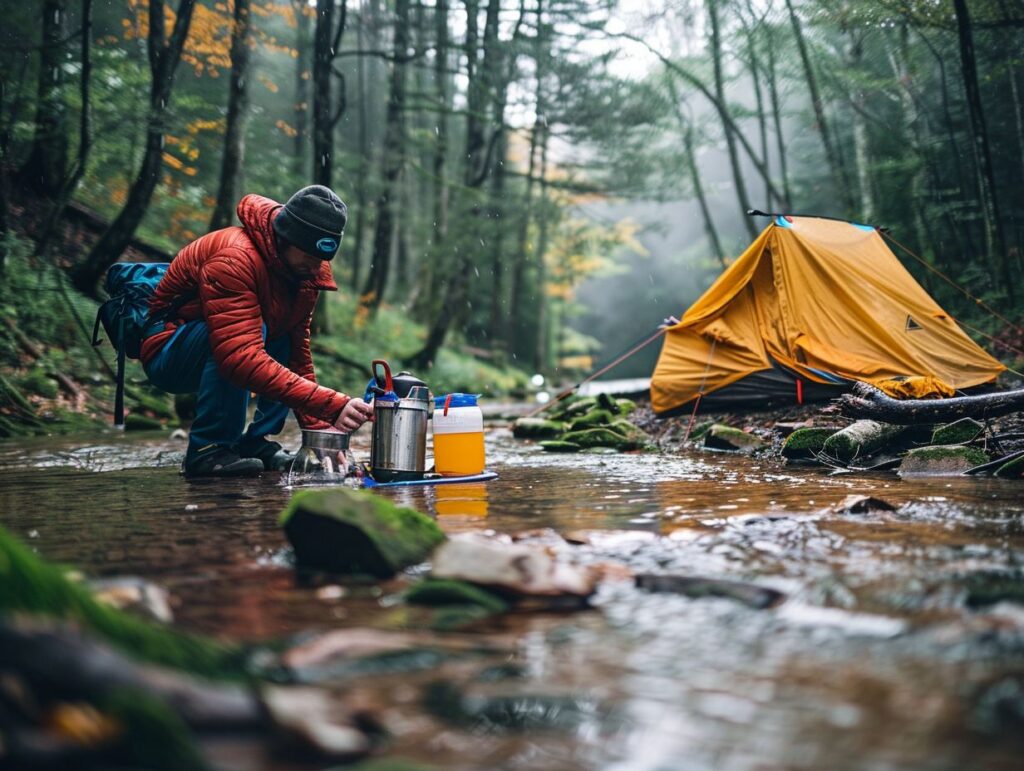When embarking on a camping adventure, one of the most crucial aspects to consider is ensuring access to clean and safe drinking water.
In this article, we will explore the importance of purifying water while camping and the various methods available to achieve this. From traditional boiling to modern UV treatment, we will discuss the pros and cons of each method and provide tips on precautions to take.
We will also explore alternative ways to purify water in the great outdoors, including using natural sources and portable water filters. Join us as we uncover the best ways to stay hydrated and healthy during your camping trip.
Key Takeaways:
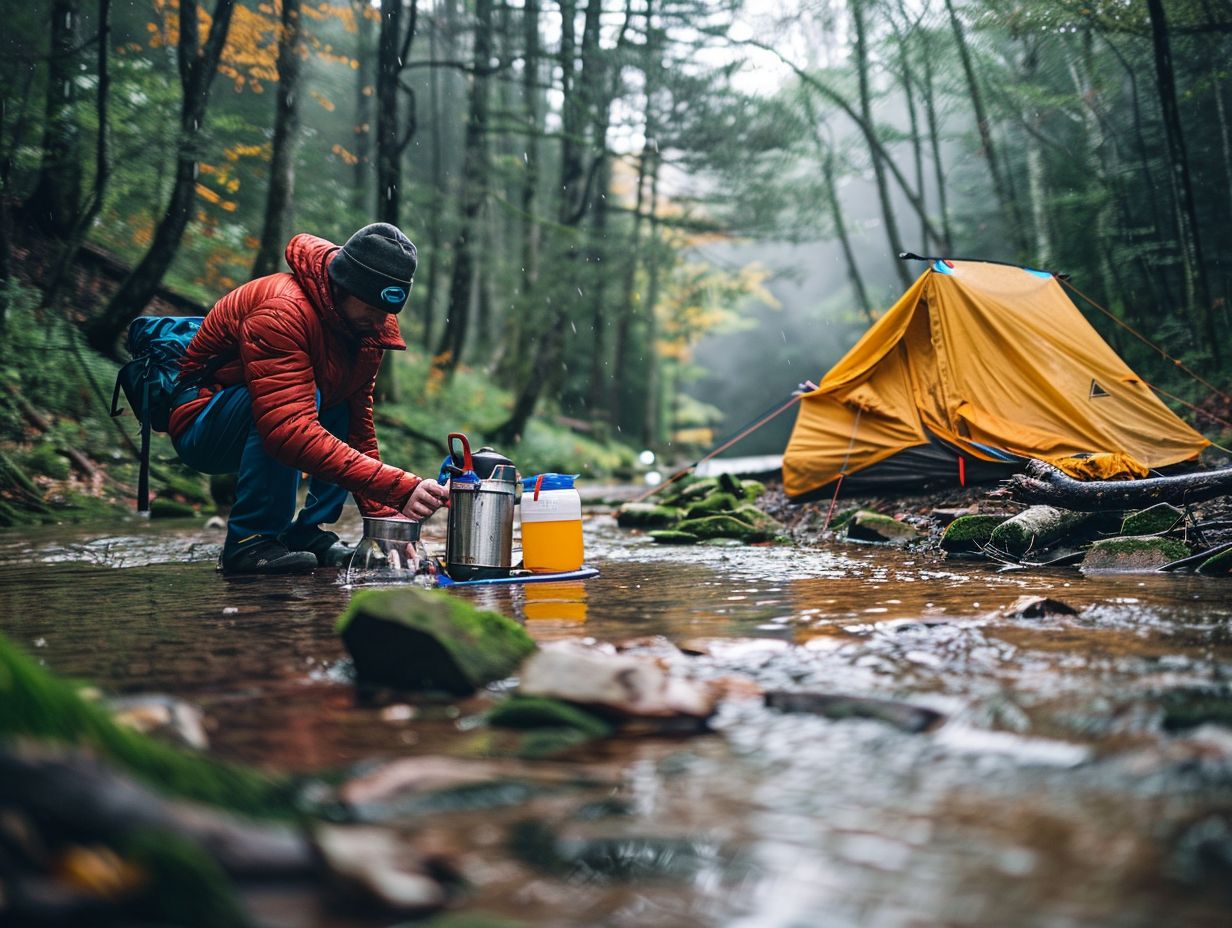
- Always purify water while camping to avoid getting sick from harmful bacteria and parasites.
- The most effective methods for purifying water while camping are boiling, chemical treatment, filtration, and UV treatment.
- Take precautions such as knowing the water source and using proper equipment when purifying water while camping, and consider alternative methods like using natural sources and portable water filters.
What Are the Different Methods of Purifying Water While Camping?
There are numerous efficient techniques for water purification during camping, each tailored to specific conditions and water sources. These methods include boiling, chemical treatment, filtration, and UV light treatment.
1. Boiling
The technique of boiling water stands out as one of the simplest and most effective methods for purifying it while engaging in camping activities, given its ability to eliminate a wide range of pathogens, including bacteria, viruses, and protozoa.
During the process of boiling water for purification purposes, it is imperative to ensure that the water attains a rolling boil, characterised by a consistent emergence of bubbles on its surface.
Generally, this sterilisation procedure necessitates a duration of approximately 1-3 minutes at a vigorous boiling point to guarantee comprehensive purification.
In camping expeditions, campers often opt for stoves such as the Jetboil Flash or MSR PocketRocket due to their efficiency and portability attributes. These stoves possess the capability to swiftly bring water to a boiling temperature, rendering them highly suitable for outdoor endeavors.
Through the act of boiling water, campers can effectively eradicate detrimental microorganisms, thereby rendering the water safe for both consumption and cooking purposes.
2. Chemical Treatment
The process of chemical treatment involves the utilization of purification tablets, such as Aquatabs, to eradicate harmful pathogens from water sources, thus rendering it potable. Purification tablets commonly incorporate chemicals like chlorine dioxide or iodine, renowned for their capacity to eradicate bacteria, viruses, and protozoa found in untreated water.
Upon introduction to a receptacle of water, these tablets dissolve and discharge the aforementioned chemicals, thereby effectively disinfecting the water.
Various types of pathogens necessitate distinct contact durations with the chemicals to be rendered inert, underscoring the importance of adhering to the prescribed instructions for each specific tablet.
For instance, Aquatabs typically mandate approximately 30 minutes of contact time to ensure comprehensive purification.
3. Filtration
Filtration serves as a commonly employed technique for water purification during camping activities. This method involves the utilisation of various water filters such as gravity, squeeze, pump, bottle, and straw filters with the aim of eliminating contaminants.
Gravity filters, exemplified by the Platypus Gravity Filter, operate by harnessing the gravitational force to propel water through a filter cartridge, effectively eliminating bacteria, protozoa, and sediment.
Conversely, squeeze filters, like the Sawyer Squeeze, function by exerting pressure to force water through a hollow fibre membrane, thereby capturing impurities.
Pump filters, typified by the MSR MiniWorks EX Water Filter, necessitate manual pumping to facilitate the passage of water through a filter, thereby ensuring the provision of clean and safe drinking water. On the other hand, bottle filters are integrated into water bottles, enabling users to directly consume water filtered through the device.
Lastly, straw filters enable individuals to consume water directly from a water source through a filter-equipped straw, offering a convenient on-the-go filtration solution.
4. UV Treatment
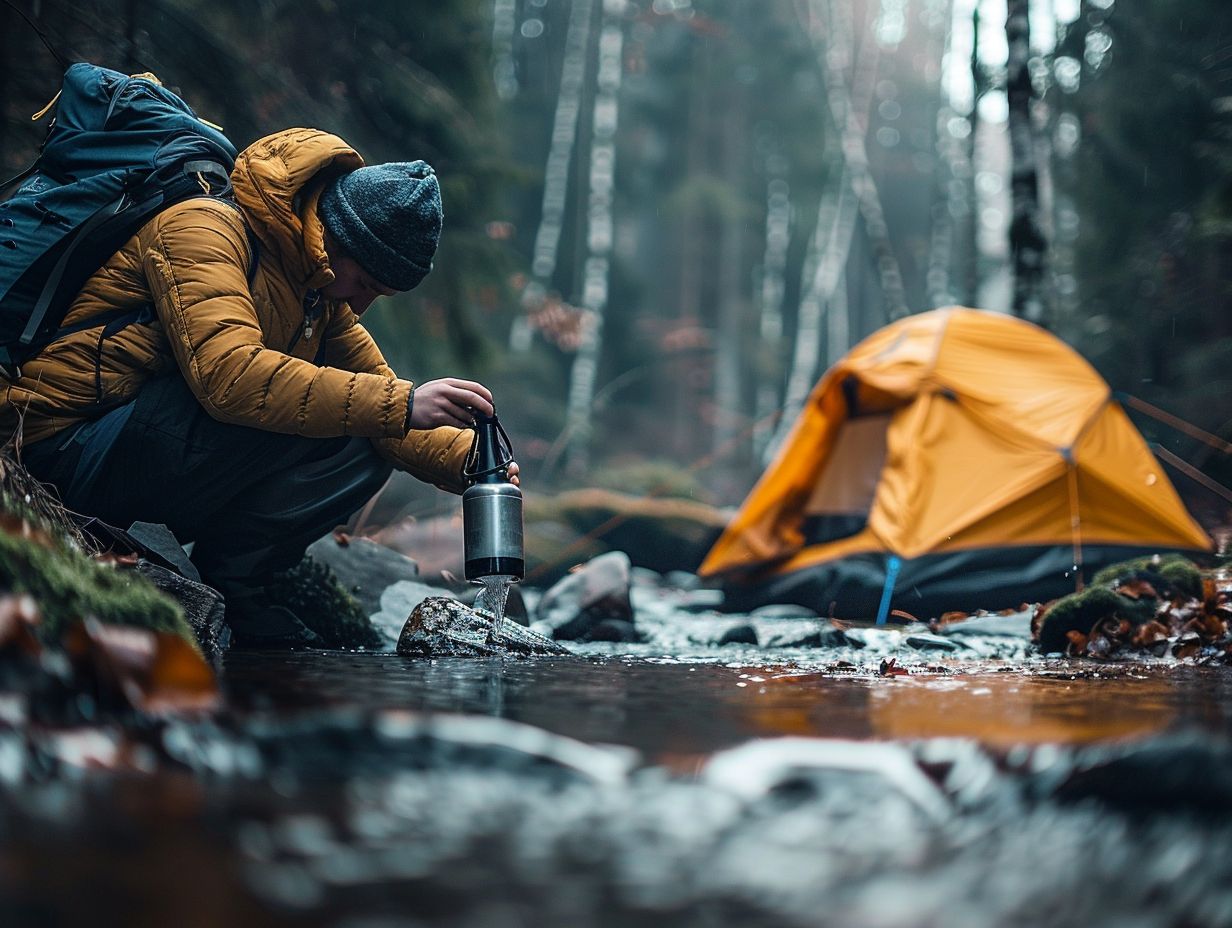
UV treatment utilises ultraviolet light to disrupt the DNA of pathogens, effectively neutralising them and rendering the water safe for consumption. When exposed to UV light, the DNA of microorganisms present in the water absorbs the UV rays, resulting in damage to their genetic material and inhibiting their ability to replicate or cause harm.
This method demonstrates particular efficacy against a broad spectrum of bacteria, viruses, and protozoa, ensuring a thorough purification process.
Devices such as the widely recognised Katadyn Steripen leverage UV technology to offer portable water treatment solutions for outdoor enthusiasts and travellers. By immersing the Steripen in a container of water and activating the UV light, users can quickly attain safe and clean drinking water without the use of chemicals or extensive waiting periods.
Which method is the most effective?
The selection of the optimal water purification method for camping is dependent on a variety of factors, such as the type of pathogens present, the water source, and the equipment available.
What Are the Pros and Cons of Each Method?
Every water purification method presents its own set of advantages and disadvantages, which can vary depending on the context and specific requirements of the camper.
Boiling water stands out as a straightforward and efficient technique for purifying water during camping excursions, as it necessitates no specialised equipment and effectively eliminates most pathogens through the application of heat. Whilst effective, this method can be time-consuming and necessitates access to a suitable heat source.
Chemical treatment, such as the utilisation of water purification tablets, is characterised by its lightweight nature and ease of portability, rendering it a convenient option for camping. However, there is a potential drawback in that certain chemicals may impart an undesirable taste to the water.
Filtration systems excel at removing bacteria and protozoa, providing clean water in a prompt manner, yet they may prove cumbersome and necessitate regular maintenance.
UV treatment, exemplified by the use of a UV pen, offers a swift and efficient means of disinfecting water. Nonetheless, this method is reliant on batteries, which may present practical challenges during more extensive camping trips.
What Are Some Precautions to Take When Purifying Water While Camping?
When purifying water during camping, it is crucial to adhere to specific precautions to ensure that the water is safe and free from pathogens.
1. Know the Water Source
It is imperative to consider the source of water whilst camping, particularly in regions like National Forests where there is a risk of water contamination from chemicals or heavy metals.
One prevalent technique for determining safe water sources in natural settings involves seeking out fast-flowing streams or springs, as they are less likely to contain stagnant water that could support the growth of bacteria. It is recommended to visually examine the water for any abnormal colours, smells, or floating debris, as these could be signs of contamination.
It is prudent to avoid water sources situated near potential sources of pollution such as agricultural fields, mines, or industrial facilities, as these locations are more vulnerable to runoff pollution. Emphasising the selection of clean water sources is essential in mitigating the risk of waterborne diseases and ensuring a secure outdoor excursion.
2. Follow Instructions Carefully
Adherence to the instructions provided for any chosen water purification method is imperative to guarantee the elimination of pathogens and ensure the potability of the water.
Failure to follow the manufacturer’s guidelines may result in inefficient purification methods and the potential presence of harmful contaminants in the water.
An example of a common error is the improper calibration of water purification equipment, leading to inadequate removal of detrimental substances. To prevent this issue, it is essential to consistently consult the manual furnished by the manufacturer for precise calibration procedures.
Moreover, neglecting to replace filters as advised can jeopardize the effectiveness of the purification system. It is of utmost importance to strictly observe the recommended filter replacement timetable to uphold the quality of the treated water.
3. Use Proper Equipment
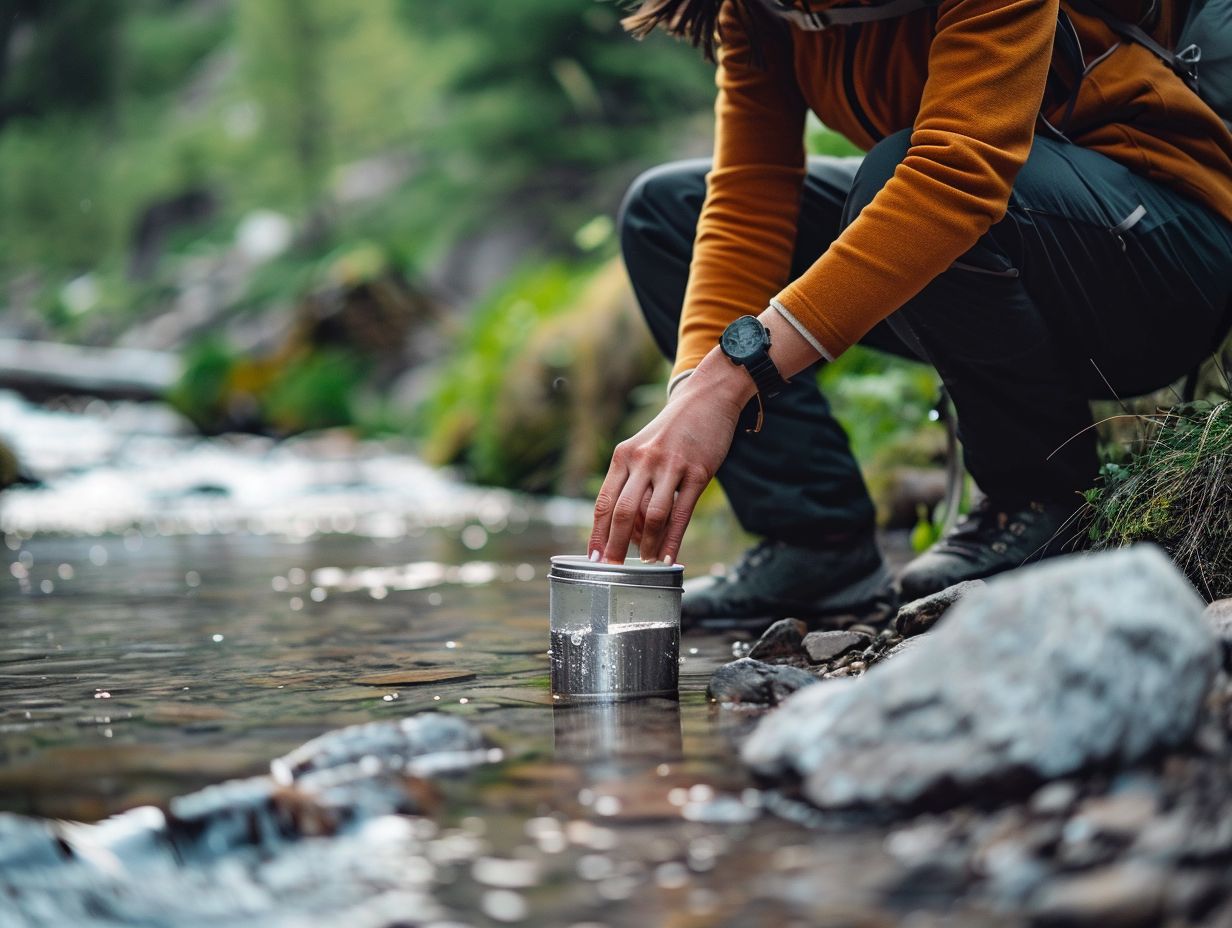
The utilisation of appropriate equipment, such as reliable water filters, stoves, purification tablets, or UV light purifiers, is imperative for effectively purifying water whilst engaging in camping activities.
It is essential to procure high-quality equipment to ensure the provision of safe drinking water during outdoor ventures. Opting for reputable brands such as Grayl GeoPress Water Filter or Katadyn BeFree Filter can offer assurance against harmful contaminants.
Maintaining these filters on a regular basis is also vital for their durability and performance. Engaging in tasks such as cleaning the filter cartridges, replacing components as necessary, and storing the equipment correctly when not in use can contribute to prolonging their lifespan and preserving their efficiency.
By attending to the maintenance of the equipment, individuals can relish in clean and safe drinking water regardless of their outdoor excursions.
What Are Some Alternative Ways to Purify Water While Camping?
Aside from conventional water purification methods, there are several alternative approaches to ensure the availability of safe drinking water during camping trips.
1. Using Natural Sources
The utilisation of natural water sources such as springs may present a feasible solution for acquiring potable drinking water, provided that one can ascertain the absence of waterborne pathogens.
An effective method to evaluate the safety of a spring as a water source involves a thorough examination of its immediate surroundings. Detecting indicators of pollution, such as the presence of industrial facilities or septic systems in close proximity that could potentially compromise the water quality, is crucial.
Additionally, assessing the flow rate of the spring is imperative; a consistent flow suggests a reduced likelihood of contamination.
Despite the potential advantages associated with the use of natural water sources like springs, inherent risks persist. These risks encompass the possibility of bacterial contamination, parasitic infestation, and chemical pollutants.
Consequently, it is essential to conduct regular assessments of the water quality to ensure that it meets the requisite standards for human consumption.
2. Using Portable Water Filters
Portable water filters, such as the LifeStraw Peak Water Filter, Sawyer Squeeze, and Katadyn BeFree Filter, offer a convenient and effective solution for water purification while on the move.
These filtration devices are engineered to eliminate impurities, bacteria, and protozoa from untreated water sources, rendering them suitable for various activities like camping, hiking, travel, and emergency situations.
Utilising these filters is straightforward – one simply needs to fill the water container, affix the filter, and consume the purified water directly from the spout or squeeze bottle. Their compact dimensions and lightweight construction allow for effortless portability in a rucksack or pocket.
By employing these filters, individuals can rest assured that they will have access to clean and safe drinking water wherever they may be, without the necessity of chemical treatments or boiling processes.
3. Using Water Purification Tablets
Water purification tablets, such as Aquatabs, offer a convenient and lightweight solution to ensure the safety of drinking water by eliminating harmful pathogens. These tablets function by releasing chlorine or iodine into the water, effectively eradicating bacteria, viruses, and other impurities.
A notable advantage of utilising water purification tablets lies in their portability, rendering them particularly suitable for outdoor pursuits like camping, hiking, or journeys to remote locales where access to clean water sources may be limited.
Furthermore, these tablets boast ease of application; users are simply required to add the tablet to a specified quantity of water, allow it to dissolve, and adhere to the prescribed timeframe for the purification process to fully take effect.
It is imperative to acknowledge that while water purification tablets excel in microbial elimination, they may not be as effective in removing sediments, chemicals, or heavy metals from water. As such, they are most suited for circumstances where microbial contamination represents the primary concern.
Frequently Asked Questions
What are the best ways to purify water while camping?
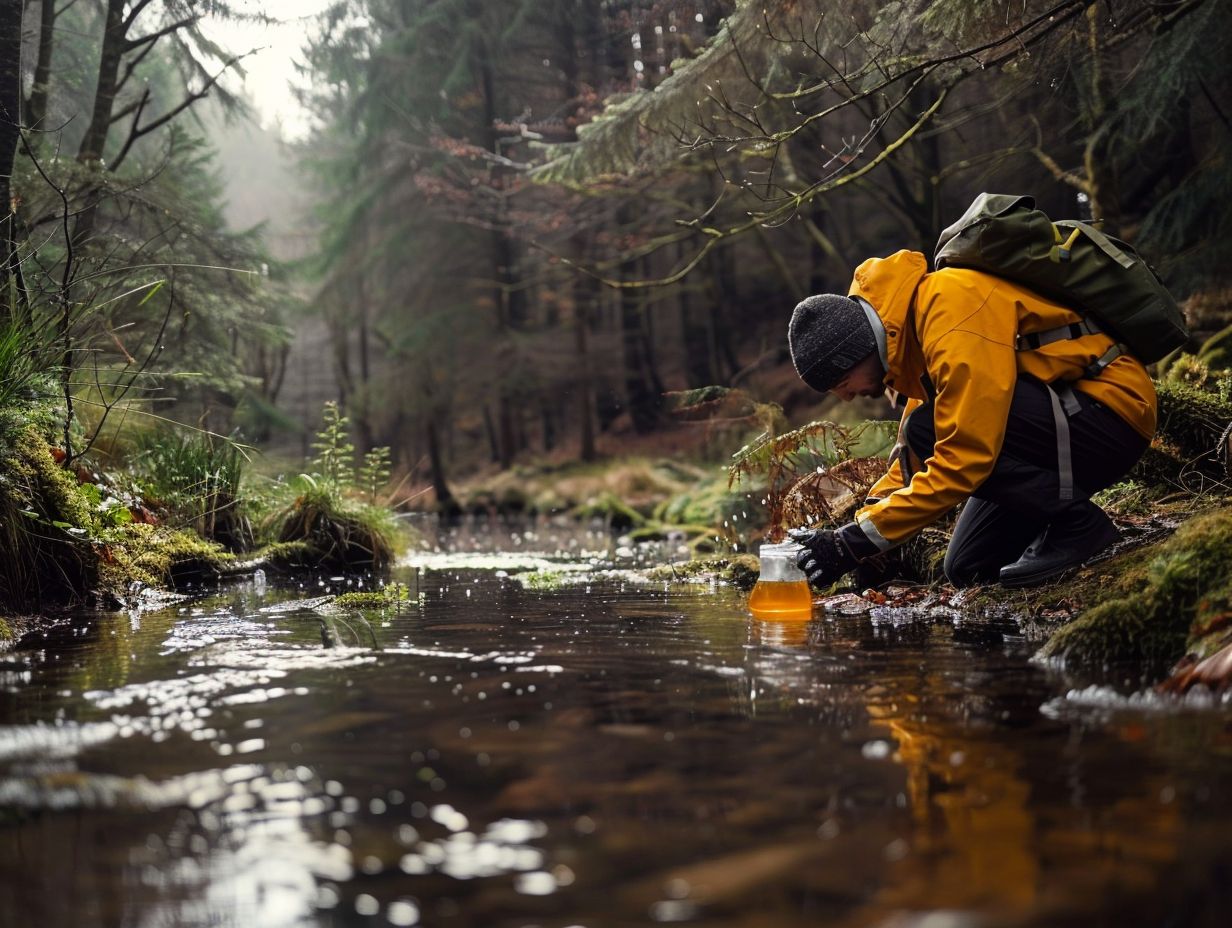
Some of the best ways to purify water while camping include boiling, using a water filter, using water purification tablets, and using UV light purifiers.
Can I use boiling to purify water while camping?
Yes, boiling is considered one of the most effective ways to purify water while camping. Simply bring the water to a rolling boil for at least one minute to kill any harmful bacteria or pathogens. Be sure to let the water cool before consuming.
What is a water filter and how does it work while camping?
A water filter is a device that removes impurities and contaminants from water. It works by passing the water through a porous material, such as charcoal or ceramic, which traps the impurities and allows clean water to pass through. Water filters are a popular choice for purifying water while camping because they are lightweight and easy to use.
How do water purification tablets work while camping?
Water purification tablets are small tablets or drops that contain chemicals, such as iodine or chlorine, that kill harmful bacteria and pathogens in water. To use them while camping, simply follow the instructions on the packaging and wait the recommended amount of time before consuming the water.
Are UV light purifiers effective for purifying water while camping?
Yes, UV light purifiers use UV rays to kill bacteria and pathogens in water. They are lightweight and easy to use, making them a popular choice for camping. Just be sure to follow the manufacturer’s instructions and use the purifier for the recommended amount of time for best results.
What other precautions should I take when purifying water while camping?
In addition to using a purification method, it is important to also properly store and handle your water. This means using clean containers and keeping them in a cool, dry place. It is also a good idea to bring enough water for your trip in case you are unable to find a water source or your purification method fails.

